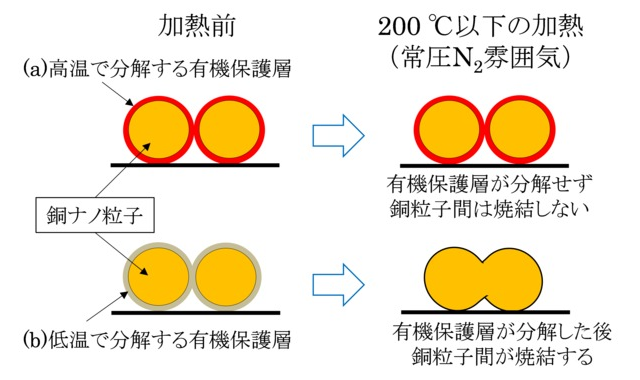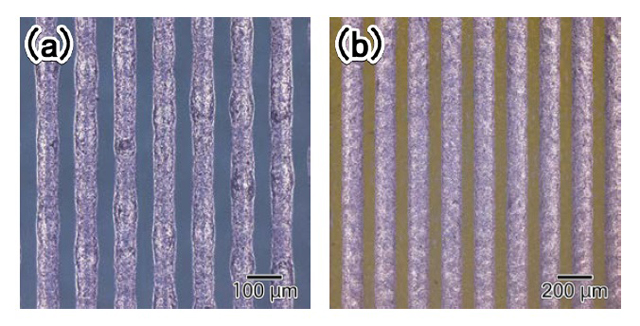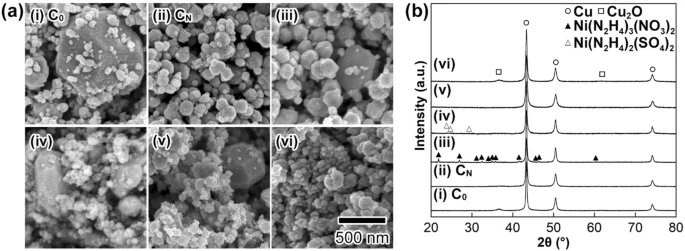

開発した銅ナノペーストをフィルム上へスクリーン印刷した後、200 °C×30 min.焼成(窒素雰囲気下の常圧焼成)して得られた配線状態図
(a):PENフィルム上への配線形成、(b):PI上への配線形成

三井金属:低温焼結可能な銅ナノ粒子:銀ペーストを代替(動画):
Mitsui Metal:Copper nanoparticles sintered at low temp:for silver paste:
三井金属:可低温烧结的铜纳米粒子:银浆的替代品
ー銅微粒子の新たな有機物フリー合成ー
~水溶性卑金属塩を利用し、グリーンな合成手法を実現~
東北大学・多元物質科学研究所
三井金属・総合研究所「導電材料として期待される銅微粒子」を、「有機物フリーで合成するプロセス」を開発。
今回開発した合成法:
水溶性の卑金属塩を用いることで、銅微粒子を合成する。
- 得られた銅微粒子は、
- 有機物を含有していないため、
- 焼成した際に 極めてガス発生量が少なく、
低温で焼結することを確認しました。
革新的な合成技術:
本手法は、
「持続可能な社会実現に向けた革新的合成技術」として期待できます。
更に、
これまでに無い新規機能を有する金属微粒子を、創製可能。
本成果:
12 月 20 日、nature.com のオープンアク セス電子ジャーナル誌「Scientific Reports」に掲載されました。 (DOI: 10.1038/s41598-021-03707-9)
発表の概要:
有機物フリー銅粒子合成プロセス
(銅前駆体湿式還元法)有機物フリー銅粒子合成プロセスをあらたに開発した。
- 卑金属塩を利用し、
- 水中、大気下、室温という、
- 低環境負荷条件において、
銅微粒子を合成できる。
省資源・省エネルギー型合成法:
有機物を使用する従来法に比べ、省資源・省エネルギー型の合成法である。
次世代エレクトロニクスの導電材料:
合成銅微粒子は、有機物を含まない。
- そのため、焼成した際に極めてガ ス発生が少ない。
- 次世代エレクトロニクスの導電材料としての応用が期 待できる。
【概要】
銅微粒子は、金や銀といった貴金属微粒子よりも、元素が豊富で安価。
貴金属類と同等の高い導電性と熱伝導性を有します。
既往の銅粒子合成法:
しかし、既往の銅粒子合成法では、有機物が添加使用されており、その分解処理が必要でした。
三井金属と東北大/「低温焼結可能な銅ナノ粒子」開発/銀ペーストからの代替期待 | 日刊鉄鋼新聞 Japan Metal Daily
https://www.japanmetaldaily.com/articles/-/41273
低温焼結性の銅ナノ粒子:低環境負荷条件で合成―プリンテッドエレクトロニクスと次世代パワーデバイス接合は銅の時代へ – fabcross for エンジニア
https://engineer.fabcross.jp/archeive/190201_tohoku.html
A mild aqueous synthesis of ligand-free copper nanoparticles for low temperature sintering nanopastes with nickel salt assistance
Scientific Reports
Abstract
An organic ligand-free aqueous-phase synthesis of copper (Cu) nanoparticles (NPs) under an air atmosphere
was successfully achieved by reducing copper(II) oxide particles with a leaf-like shape in the presence of Ni salts at room temperature.
The resulting Cu NPs with a mean particle diameter of ca. 150 nm
exhibited low-temperature sintering properties due to their polycrystalline internal structure and ligand-free surface.
These Cu NPs
were applied to obtain Cu NP-based nanopastes with low-temperature sintering properties,and the resistivities of the obtained Cu electrodes after annealing at 150 °C and 200 °C for 30 min were 64 μΩ∙cm and 27 μΩ∙cm, respectively.
The bonding strength between oxygen-free Cu plates prepared using the Cu NP-based nanopastes
reached 32 MPa after pressure-less sintering at 260 °C for 30 min under a nitrogen atmosphere.
The developed manufacturing processes using the developed Cu nanopastes
could provide sustainable and low-CO2-emission approaches
to obtain Cu electrodes on flexible films and high-strength bonding between metal plates as die-attach materials for power devices under energy- and resource-saving conditions.